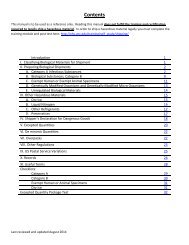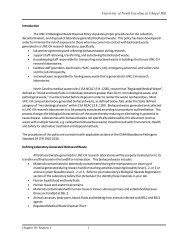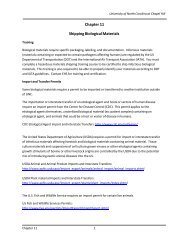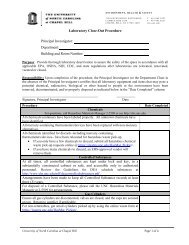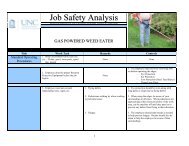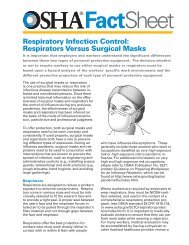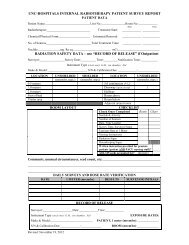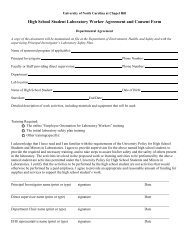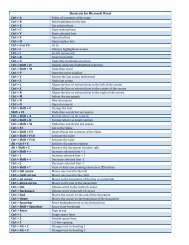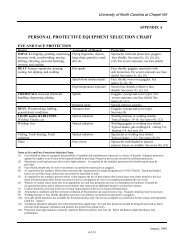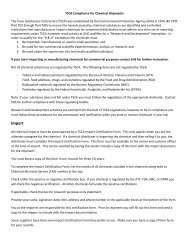WELDING AND CUTTING SAFETY POLICY - Department of ...
WELDING AND CUTTING SAFETY POLICY - Department of ...
WELDING AND CUTTING SAFETY POLICY - Department of ...
You also want an ePaper? Increase the reach of your titles
YUMPU automatically turns print PDFs into web optimized ePapers that Google loves.
The University <strong>of</strong> North Carolina at Chapel Hill<br />
HOT WORK - <strong>WELDING</strong> <strong>AND</strong> <strong>CUTTING</strong> <strong>SAFETY</strong> <strong>POLICY</strong><br />
(OSHA 1910.251-1910.255)<br />
PURPOSE<br />
This policy is to ensure UNC employee safety during welding and cutting operations along with<br />
the protection <strong>of</strong> property (including equipment) from Hot Work operations conducted at the<br />
University. Hot Work is defined as “work involving burning, welding, or similar operation that<br />
is capable <strong>of</strong> initiating fires or explosions.”<br />
For specific safety requirements for the use <strong>of</strong> compressed gas cylinders, refer to the IMAC<br />
Safety Manual Chapter, Compressed Gas Cylinder Safety.<br />
RESPONSIBILITES<br />
Environment, Health & Safety (EHS) <strong>Department</strong>:<br />
EHS is responsible for reviewing hazards and incidents associated with Hot Work conducted on<br />
campus along with developing training programs for Hot Work operations, performing health<br />
hazard evaluations, and performing safety inspections <strong>of</strong> welding work areas and equipment.<br />
Supervisor.<br />
Supervisors are responsible in making sure employees who will be performing Hot Work<br />
operations are properly train on the UNC procedures before performing work on campus. A<br />
JSA should be developed that provides specifies written rules and instructions covering when<br />
Hot Work Permit is required, the safe operation <strong>of</strong> equipment, incorporating information from<br />
Material Safety Data Sheets (MSDS) welding materials used, appropriate PPE, evaluation <strong>of</strong><br />
combustible materials and hazardous areas present or likely to be present in the work location.<br />
Whenever a Hot Work Permit is required, the Supervisor is responsible for designating the<br />
following:<br />
• Hot Work Operator: Is the <strong>Department</strong>al employee who is qualified and authorized by<br />
management to perform hot work such as welding, brazing, soldering, and other<br />
associated work tasks.<br />
• Permit Authorizing Individual: is the <strong>Department</strong>al employee who trained and is<br />
authorized to issue a hot work permit by management.<br />
• Fire Watch: is the <strong>Department</strong> employee who is trained in hot work safety and monitors<br />
the hot work area for changing conditions and watches for fires and extinguishes them if<br />
possible.<br />
1
The University <strong>of</strong> North Carolina at Chapel Hill<br />
Employee<br />
Employee performing hot work SHALL:<br />
• Before use <strong>of</strong> welding equipment, read and understand all safety practices outlined in the<br />
manufacture instruction manual for the specific type(s) <strong>of</strong> welding equipment used for<br />
the work process. Read and understand Material Safety Data Sheets (MSDSs), and<br />
Work Unit Specific Safety Practices (e.g. SOPs, JSA) and safety requirements <strong>of</strong> this<br />
Policy.<br />
• Employees performing hot work, <strong>Department</strong>al Hot Work Permit Authorizing<br />
Individual(s) (PAI), Fire Watches, and Supervisors <strong>of</strong> hot work operations, must<br />
complete annual Fire Safety Training (“hands-on”) and complete the Hot Work Safety<br />
Training Module located on the EHS website: www.ehs.unc.edu/ training/ self-study<br />
unit.<br />
• Inspect all welding equipment daily prior to use.<br />
• Shall perform a hazard assessment before work or during any unusual welding<br />
operations are planned.<br />
• Shall follow all the safety requirements outlined in the issued Hot Work Permit.<br />
• Use all required welder personal protective equipment for the specific job.<br />
• Report any unsafe condition immediately to the Supervisor.<br />
HAZARD IDENTIFICATION <strong>AND</strong> PREVENTION<br />
Fire Prevention and Protection for Welding and Cutting:<br />
Welding, cutting, and allied processes produce molten metal, sparks, slag, and hot work surfaces<br />
can cause fire or explosion if precautionary measures are not followed.<br />
Flying sparks are the main cause <strong>of</strong> fires and explosions in welding and cutting. Sparks can<br />
travel up to 35 feet from the work area. Sparks and molten metal can travel greater distances<br />
when falling. Sparks can pass through or become lodged in cracks, clothing, pipe holes, and<br />
other small openings in floors, walls, or partitions. Typical combustible materials found inside<br />
buildings include: wood, paper, rags, clothing, chemicals, flammable liquids and gases, and<br />
dusts. Parts <strong>of</strong> buildings such as floors, partitions, and ro<strong>of</strong>s may also be combustible. Welding<br />
and cutting can cause explosions in spaces containing flammable gases, vapors, liquids, or<br />
dusts.<br />
Fire Hazard Prevention Tips:<br />
• Whenever possible, relocate the work from the work site to the welding/maintenance<br />
shop area. Welding and cutting operations shall ideally be conducted in a separate, wellventilated<br />
room with a fire-retardant floor.<br />
• When not possible to relocate work to the welding shop: remove combustible materials<br />
for a minimum radius <strong>of</strong> 35 feet (10.7 meters) around the work area or move the work to<br />
a location well away from combustible materials.<br />
2
The University <strong>of</strong> North Carolina at Chapel Hill<br />
• Protect combustibles with covers made <strong>of</strong> fire-resistant materials (see page 14 <strong>of</strong> this<br />
Policy for a description <strong>of</strong> approved fire-resistant materials for hot work).<br />
• If possible, enclose the work area with portable, fire-resistant screens.<br />
• Cover or block all openings, such as doorways, windows, cracks, or other openings with<br />
fire resistant material.<br />
• When needed, have a qualified firewatcher in the work area during and for at least 30<br />
minutes after hot work is finished.<br />
• Do not dispose <strong>of</strong> hot slag in containers holding combustible material.<br />
• Fire extinguishers shall be maintained in a state <strong>of</strong> readiness for instant use.<br />
• Welding or cutting is not permitted in or near rooms containing flammable or<br />
combustible liquids, vapors, or combustible dusts. Do not weld or cut in atmospheres<br />
containing reactive, toxic, or flammable gases, vapors, liquids, or dust.<br />
• Do not apply heat to a work piece covered by an unknown substance or coating that can<br />
produce flammable, toxic, or reactive vapors when heated.<br />
• Provide safety supervision for outside contractors conducting hot work. Inform<br />
contractors about site-specific hazards including the presence <strong>of</strong> flammable materials.<br />
Hot Work Permit Requirements:<br />
Employees that perform hot work outside <strong>of</strong> designated Welding Shop and Maintenance Shop<br />
areas must complete a UNC Hot Work Permit (see Appendix A) prior to conducting hot work<br />
operations and post original at job site and provide EHS with a copy <strong>of</strong> the initial (before work)<br />
and the final sign-<strong>of</strong>f (after work is completed). The Supervisor, <strong>Department</strong>al Permit<br />
Authorizing Individual, and Hot Work Operator are responsible for ensuring compliance with<br />
the permit requirements. The information contained on the UNC Hot Work Permit is based<br />
from NFPA 51B, Standard for Fire Prevention During Welding, Cutting, and Other Hot Work.<br />
The PAI must document the following on the Hot Work Permit:<br />
1. Date the Permit is being issued. A Permit is only valid for one day <strong>of</strong> work.<br />
2. Building/Location/Floor Level where hot work will be taking place.<br />
3. Document type <strong>of</strong> work to be performed (i.e. Overhead MIG Welding)<br />
4. The PAI then shall inspect the work area and confirm that precautions have been taken<br />
to prevent a fire. The PAI must complete the checklist outlined on the Hot Work Permit<br />
which includes observing special precautions needed during work such as posting a fire<br />
watch, and ensuring the hot work location is free from hazards within 35 feet <strong>of</strong> the<br />
work area where hot work is planned.<br />
5. Document any special precautions for the work to be performed such as the use <strong>of</strong><br />
supplemental fire extinguishers, welding blankets, welding curtains, and ensuring<br />
combustible materials are not present and guarding materials that cannot be relocated as<br />
a last line <strong>of</strong> defense where hot work is planned.<br />
6. The PAI must inspect if hot work is planned near or on walls, ceilings, and ro<strong>of</strong>s. These<br />
areas must be inspected for fire hazards.<br />
7. Hot work is prohibited on enclosed equipment, such as in, on, near tanks, vessels, or<br />
3
The University <strong>of</strong> North Carolina at Chapel Hill<br />
containers that contain or have contained flammable substances.<br />
8. Hot work is prohibited in areas with the accumulation <strong>of</strong> dusts.<br />
9. The PAI must ensure that the Fire Watch is provided during hot work and for 30 minutes<br />
after the completion <strong>of</strong> hot work.<br />
10. The PAI must ensure the Fire Watch is supplied with appropriate fire extinguishers<br />
and/or fire suppression equipment (e.g. water hose).<br />
11. The Fire Watch must be able to activate the fire alarm and be able to contact the Fire<br />
<strong>Department</strong> in the event <strong>of</strong> an emergency.<br />
12. The PAI must determine if more than one fire watch is required in adjoining areas,<br />
above level and below areas.<br />
13. The Fire Watch must perform a final check <strong>of</strong> the work area and adjacent areas to which<br />
sparks and heat might spread (including floors above and below, and on opposite side <strong>of</strong><br />
wall(s). 30 minutes after the hot work was completed and verify with the PAI that the<br />
area was found safe.<br />
14. After completion <strong>of</strong> the Hot Work Permit, a copy <strong>of</strong> the completed Permit must be<br />
submitted to the Environment, Health, and Safety <strong>Department</strong> via University Mail<br />
(Attention: EHS <strong>Department</strong>, CB#1650), or hand delivered.<br />
Hot Work Locations:<br />
Hot work is never permitted in certain types <strong>of</strong> locations where safe conditions do not exist and<br />
cannot be created. Hot work is allowed in two types <strong>of</strong> locations:<br />
Designated area is a permanent location approved for routine hot work operations made safe by<br />
removal <strong>of</strong> all possible sources <strong>of</strong> ignition that could be ignited by the hot work tool. An<br />
example is the Welding Shop or Maintenance Shop where all combustibles have been removed.<br />
A Hot Work Permit is not required in a Designated Hot Work Area.<br />
Controlled Area is one in which safe conditions for hot work exist or where safe conditions can<br />
be created by moving or protecting combustibles. An example <strong>of</strong> a controlled area is in a<br />
campus building construction area where welding must take place and the work area has been<br />
made safe by removing all combustibles and implementing the requirements <strong>of</strong> the hot work<br />
permit in order to make it safe.<br />
• In a Controlled Area, a Hot Work Permit must be obtained by the hot work<br />
operator.<br />
• The permit must be obtained from the Supervisor or <strong>Department</strong>al designated<br />
Permit Authorizing Individual (PAI) before the hot work can proceed in a<br />
controlled area.<br />
• Refer to the next page <strong>of</strong> this Policy for the UNC-CH Hot Work Permit that is to<br />
be used before commencing hot work activities.<br />
• A Hot Work Permit is good for only one day <strong>of</strong> work. A copy <strong>of</strong> the Permit must<br />
4
The University <strong>of</strong> North Carolina at Chapel Hill<br />
be forwarded to the EHS <strong>Department</strong> for data tracking by the Fire Safety Section.<br />
Non-Permissible Locations: is a location that cannot be made safe for hot work and hot work<br />
is not permitted in these locations. An example is near closed tanks that contain or have<br />
contained flammable liquids such as a fuel tank.<br />
Welding and Hot Work In and Around Tanks:<br />
UNC-CH adheres to U.S. Chemical Safety Board recommendations for welding or cutting<br />
operations in or near tanks. Whenever possible, avoid hot work and consider alternative<br />
methods. Analyze the hazards, prior to initiation <strong>of</strong> hot work perform a hazard assessment that<br />
identifies the scope <strong>of</strong> work, potential hazards, and methods <strong>of</strong> hazard control.<br />
• Work is not allowed and shall not be performed in or near closed tanks that contain or<br />
have contained flammable liquids. The tanks must be thoroughly drained, purged, and<br />
atmospherically tested with a combustible gas meter (indicator). This will ensure the<br />
tank is free from the accumulation <strong>of</strong> flammable gases or vapors.<br />
• Once approved safe for hot work, atmospheric monitoring must be performed using a<br />
portable combustible gas analyzer before and during the work by only trained personnel<br />
(PAIs or EHS staff). Assistance can be obtained with atmospheric monitoring by<br />
contacting EHS <strong>Department</strong> at 962-5507.<br />
• If any detectable readings are obtained, then work cannot begin or continue until the<br />
source <strong>of</strong> vapor is found and suitably mitigated such that the concentration is maintained<br />
below 10% <strong>of</strong> the Lower Flammable/Explosive Limit. For technical assistance regarding<br />
combustible gas meters, contact EHS Industrial Hygiene or Fire Safety Section at 962-<br />
5507.<br />
Electric Shock Hazards and Safety Precautions:<br />
Electric shock from electrical welding and cutting equipment can result in death or severe burns.<br />
Additionally, serious injury can occur if the welder falls as a result <strong>of</strong> the shock. This safety<br />
hazard is associated with operations that use electricity to generate heat, such as arc and<br />
resistance welding and cutting.<br />
Employees are to use proper precautionary measures and recommended safe practices at all<br />
times to avoid electrical shocks. Personnel using electrical welding and cutting equipment must<br />
be trained on safe work practices and procedures before use <strong>of</strong> this equipment. Some measures<br />
to prevent electrical shock include:<br />
• Never use a bare hand or wet glove to change electrodes.<br />
• Do not touch an energized electrode while you are in contact with the work circuit.<br />
• Never stand on a wet or grounded surface when changing electrodes.<br />
5
The University <strong>of</strong> North Carolina at Chapel Hill<br />
• Do not allow the electrode holder or electrode to come in contact with any other person<br />
or any grounded object.<br />
• Ground the frames <strong>of</strong> welding units.<br />
• Insulate yourself from the workpiece and ground using dry insulating mats or covers<br />
big enough to prevent any physical contact with the work or ground, or wear properly<br />
designed and approved rubber-soled boots in good condition.<br />
• If utilizing long lengths <strong>of</strong> cable, suspend them overhead whenever possible. If run<br />
along the floor, be sure they do not create a tripping hazard, become damaged, or<br />
tangled.<br />
• Additional safety precautions are required when welding is performed under any <strong>of</strong> the<br />
following electrical hazardous conditions: in damp locations or while wearing wet<br />
clothing, on metal floors, gratings, scaffolds, or other metal structures; in cramped<br />
positions such as sitting, kneeling, or lying; or when there is a high risk <strong>of</strong> unavoidable<br />
or accidental contact with the workpiece and ground. Where these conditions are<br />
present, use one <strong>of</strong> the following types <strong>of</strong> equipment presented in order <strong>of</strong> preference:<br />
1) Semiautomatic DC constant voltage metal electrode (wire) welder,<br />
2) DC manual covered electrode (stick) welder,<br />
3) AC welder with reduced open-circuit voltage. In most situations, use <strong>of</strong> a DC<br />
constant voltage wire welder is recommended. And do not work alone!<br />
Ventilation Requirements for Welding:<br />
Adequate ventilation shall be provided for all welding and cutting and related operations.<br />
Adequate ventilation shall be enough ventilation such that personnel exposures to hazardous<br />
concentrations <strong>of</strong> airborne contaminants are maintained below the allowable limits.<br />
Ventilation is used to control overexposures to the fumes and gases during welding and cutting.<br />
Adequate ventilation will keep the fumes and gases from the welder’s breathing zone. The heat<br />
<strong>of</strong> the arc or flame creates fumes and gases (fume plume). Fumes contain respirable particles.<br />
Gases include the shielding gas, and combustion products. The heat from the arc or flame<br />
causes the fume plume to rise. Overexposure to welding fumes and gases can cause dizziness,<br />
illness, and even unconsciousness and death. The following measures and precautions are to be<br />
instituted to protect employee health:<br />
• General Welder Safety Precautions: Keep your head out <strong>of</strong> the fume plume.<br />
Reposition the work, your head, or both to keep from breathing smoke and fumes. Do<br />
not breathe the fumes. Use ventilation to control the fumes and gases produced from<br />
cutting and welding.<br />
• Adequate ventilation: All welding, cutting, and heating operations shall be ventilated<br />
(natural or mechanical) such that personnel exposures to hazardous concentrations <strong>of</strong><br />
airborne contaminants are within acceptable limits. Adequate ventilation can be<br />
6
The University <strong>of</strong> North Carolina at Chapel Hill<br />
obtained through natural or mechanical means or both.<br />
a) Natural ventilation is the movement <strong>of</strong> air through a workplace by natural forces.<br />
Ro<strong>of</strong> vents, open doors and windows provide natural ventilation. The size and<br />
layout <strong>of</strong> the area/building can affect the amount <strong>of</strong> airflow in the welding area.<br />
Natural ventilation can be acceptable for welding operations if the contaminants are<br />
kept below the allowable limits.<br />
b) Mechanical ventilation is the movement <strong>of</strong> air through a workplace by a<br />
mechanical device such as a fan. Mechanical ventilation is reliable. It can be more<br />
effective than natural ventilation. An example is a local exhaust ventilation system.<br />
These systems include a capture device, ducting, hood, and a fan. The capture<br />
devices remove fumes and gases at their source. Some systems filter the airflow<br />
before exhausting it. Fixed or moveable capture devices are placed near or around<br />
the work. They can keep contaminants below allowable limits. When using<br />
mechanical ventilation remember to:<br />
1) Locate the hood as close as possible to the work.<br />
2) Position the hood to draw the plume away from the breathing zone.<br />
3) Curtains may be used to direct airflow.<br />
Above Illustrations: Courtesy Washington State Labor and Industries<br />
• Cutting <strong>of</strong> Stainless Steel: Oxygen cutting, using either a chemical flux or iron powder<br />
7
The University <strong>of</strong> North Carolina at Chapel Hill<br />
or gas-shielded arc cutting <strong>of</strong> stainless steel, shall be done using mechanical ventilation<br />
adequate to remove the fumes generated.<br />
• Below is an illustration <strong>of</strong> a portable mechanical local exhaust system (property <strong>of</strong><br />
Energy Services, Chilled Water Services) that is used for welding and cutting hot work<br />
at <strong>of</strong>f site locations. It has been used by other <strong>Department</strong>s during hot work. EHS<br />
endorses the use <strong>of</strong> this type <strong>of</strong> system to help control welding fumes when welding and<br />
cutting outside <strong>of</strong> shop areas.<br />
PERSONAL PROTECTIVE EQUIPMENT FOR <strong>WELDING</strong> <strong>AND</strong> <strong>CUTTING</strong><br />
Employees exposed to the hazards created by welding, cutting, or brazing operations shall be<br />
protected by personal protective equipment (PPE) in accordance with the requirements <strong>of</strong><br />
OSHA standard 1910.132. Appropriate protective clothing required for any welding operation<br />
will vary with the size, nature and location <strong>of</strong> the work to be performed. PPE must protect<br />
against hazards such as burns, sparks, spatter, electric shock, and optical radiation.<br />
Body Protection:<br />
Clothing shall provide sufficient coverage, and be made <strong>of</strong> suitable materials, to minimize skin<br />
burns caused by sparks, spatter, or radiation. Wear oil-free protective clothing made <strong>of</strong> wool or<br />
heavy cotton. Heavier materials work best. Choose clothing that allows freedom <strong>of</strong> movement<br />
and covers all areas <strong>of</strong> exposed skin. Wear long sleeved shirts (no t-shirts), and button the cuffs,<br />
pockets, and collar. They will protect your arms and neck from exposure and skin burns. Wear<br />
leather aprons (leather or other material that protects against radiated heat and sparks), leggings,<br />
capes, and sleeves as needed for the application. Keep clothing dry. Change it when needed<br />
(this reduces the possibility <strong>of</strong> electric shock). Keep clothing clean (free <strong>of</strong> oil, grease, or<br />
solvents which may catch fire and burn easily). Keep it in good repair (no holes, tears, or frayed<br />
edges). Always follow the manufacturer’s direction for their use, care, and maintenance.<br />
Remove all flammables and matches and cigarette lighters from your pockets. Do not wear<br />
synthetic (man-made) fabrics because they may burn easily, melt, stick to your skin, and cause<br />
serious burns. Below is an illustration <strong>of</strong> a welding jacket that is used by a Campus Shop -<br />
Courtesy UNC-CH Physics Shop.<br />
8
The University <strong>of</strong> North Carolina at Chapel Hill<br />
Foot & Leg Protection:<br />
Wear leather, steel-toed, high-topped boots in good condition. They will help protect your feet<br />
and ankles from injury. In heavy spark and slag areas, use fire-resistant boot protectors or<br />
leather spats strapped round your pant legs and boot tops to prevent injury and burns. Do not<br />
wear pants with cuffs. Wear the bottoms <strong>of</strong> your pants over the tops <strong>of</strong> your boots to keep out<br />
sparks and flying metal. Do not tuck pant legs into your boots.<br />
Hand Protection:<br />
Wear flame-resistant gloves, such as leather welder’s gloves. Always wear dry, hole-free,<br />
insulated welding gloves in good condition. They will help protect your hands from burns,<br />
sparks, heat, cuts, scratches, and electric shock.<br />
Hearing Protection:<br />
If loud noise is present, wear approved ear plugs or ear muffs to protect your hearing and<br />
prevent hearing loss. When working out <strong>of</strong> position, such as overhead, wear approved earplugs<br />
or muffs. They prevent sparks, spatter, and hot metal from entering your ears and causing<br />
burns.<br />
Respiratory Protective Equipment:<br />
When controls such as ventilation fail to control airborne contaminants to allowable levels or<br />
when the implementation <strong>of</strong> such controls is not feasible, respiratory protective equipment shall<br />
be used to protect employees from hazardous concentrations <strong>of</strong> air contaminants. Only<br />
approved respiratory protection (NIOSH approved respirators) shall be used and employee use<br />
<strong>of</strong> respirators must meet the University Respiratory Protection Program Requirements.<br />
Eye and Face Protection:<br />
Welding, cutting, and allied hot work processes presents various hazards to the welder’s eyes<br />
and face: the intense heat from arc rays and welding sparks can cause burns to the skin and<br />
eyes, during electric welding and welding processes. Personal Protective Equipment for the<br />
eyes and face is very important for both the welder and other personnel working near welding<br />
operations. Filter lens shall be in accordance with ANSI Z87.1.<br />
-For Electric Arc Welding and Arc Cutting: Helmets with filter lenses and cover lenses shall be<br />
used by operators and nearby personnel when viewing the arc. For electric welding, the<br />
minimum lens shade should be at least #10. If the electrodes are larger than 5/32” a darker lens<br />
compensates for the additional amperage required for the electrode. If the process uses a<br />
9
The University <strong>of</strong> North Carolina at Chapel Hill<br />
shielding gas, the lens shade should increase to at least #11 or #12. A darker shade is necessary<br />
because the presence <strong>of</strong> the gas increases the reflective intensity <strong>of</strong> the arc. See the below<br />
OSHA welding and cutting lens selector guide for the selection <strong>of</strong> welding lens for this process.<br />
-For Oxyfuel Gas Welding and Cutting: Welding helmets with a filter lens <strong>of</strong> #5 is the minimum<br />
protection for gas welding and cutting; however the protection required may increase to shade<br />
#8 dependent on the operation. Goggles or other approved eye protection shall be worn by<br />
persons in the work area during oxyfuel gas welding and cutting operations. See the below<br />
OSHA welding and cutting lens selector guide for the selection <strong>of</strong> welding lens for this process.<br />
Above Illustration: The above welding helmet(s) are used for head, face, and eye protection which welders use adjustable (auto lens and Auto<br />
Darkening Helmet)- Courtesy UNC-CH Physics Shop.<br />
For Other Work Associated with Welding (Such as Grinding): Welding helmets with filter<br />
lenses are intended to protect users from arc rays and from weld sparks and spatter which<br />
impinge directly against the helmet. They are not intended to protect against slag chips,<br />
grinding fragments, wire wheel bristles, and similar hazards. Spectacles with side shields or<br />
impact safety goggles, combined with the use <strong>of</strong> a face shield approved at the ANSI Z87+ level<br />
is required for protection against these hazards. The PPE should be stamped ANSI Z87+. The<br />
spectacles or goggles may have either clear or filtered lenses, depending upon the amount <strong>of</strong><br />
exposure to adjacent welding or cutting radiation. Others in the immediate welding area should<br />
wear similar eye protection.<br />
OSHA Welding Lens Selector Guide: The following is a guide for the selection <strong>of</strong> the proper<br />
shade numbers for welding and cutting eye protection. These recommendations may be varied<br />
to suit the individual's needs to protect against infrared and ultraviolet light.<br />
___________________________________________________________________________<br />
| Suggested<br />
Welding operation<br />
| Shade No.<br />
_________________________________________________________|__________<br />
|<br />
Shielded metal-arc welding - 1/16-, 3/32-, 1/8-, |<br />
5/32-inch electrodes ................................. | 10<br />
Gas-shielded arc welding (nonferrous) - 1/16-, 3/32-, |<br />
1/8-, 5/32-inch electrodes .......................... | 11<br />
Gas-shielded arc welding (ferrous) - 1/16-, 3/32-, 1/8-, |<br />
10
The University <strong>of</strong> North Carolina at Chapel Hill<br />
5/32-inch electrodes ................................. | 12<br />
Shielded metal-arc welding: |<br />
3/16-, 7/32-, 1/4-inch electrodes .................... | 12<br />
5/16 -, 3/8-inch electrodes .......................... | 14<br />
Atomic hydrogen welding ................................ | 10-14<br />
Carbon arc welding ..................................... | 14<br />
Soldering .............................................. | 2<br />
Torch brazing .......................................... | 3 or 4<br />
Light cutting, up to 1 inch ............................ | 3 or 4<br />
Medium cutting, 1 inch to 6 inches ..................... | 4 or 5<br />
Heavy cutting, 6 inches and over ....................... | 5 or 6<br />
Gas welding (light) up to 1/8 inch..................... | 4 or 5<br />
Gas welding (medium) 1/8 inch to 1/2 inch .............. | 5 or 6<br />
Gas welding (heavy) 1/2 inch and over .................. | 6 or 8<br />
_________________________________________________________|__________<br />
NOTE: In gas welding or oxygen cutting where the torch produces a<br />
high yellow light, it is desirable to use a filter or lens that<br />
absorbs the yellow or sodium line in the visible light <strong>of</strong> the<br />
operation.<br />
_____________________________________________________________________________<br />
APPROVED FIRE RESISTANT MATERIALS FOR HOT WORK AREAS<br />
Welding Blanket. A heat-resistant fabric designed to be placed in the vicinity <strong>of</strong> a hot work<br />
operation. Intended for use in horizontal applications with light to moderate exposures such as<br />
that resulting from chipping, grinding, heat treating, sand blasting, and light horizontal welding.<br />
Designed to protect machinery and prevent ignition <strong>of</strong> combustibles such as wood that are<br />
located adjacent to the underside <strong>of</strong> the blanket. They are made from different materials such as<br />
fiberglass, Silica, and other fire resistant materials.<br />
Above Illustration: Courtesy <strong>of</strong> Northern Tool & Equipment Company<br />
Welding Pads. A heat-resistant fabric designed to be placed directly under a hot work<br />
operation such as welding or cutting. Welding pads are intended for use horizontal applications<br />
with severe exposures such as that resulting from molten substances <strong>of</strong> heavy horizontal<br />
welding. Designed to prevent the ignition <strong>of</strong> combustibles that are located adjacent to the<br />
underside <strong>of</strong> the pad.<br />
Welding Curtain. A heat-resistant fabric designed to be placed in the vicinity <strong>of</strong> a hot work<br />
11
The University <strong>of</strong> North Carolina at Chapel Hill<br />
operation. Intended for use in vertical application with light to moderate exposures such as that<br />
resulting from chipping, grinding, heat treating, and light horizontal welding. Designed to<br />
prevent sparks from escaping a confined area.<br />
Below: Illustration Courtesy <strong>of</strong> UNC Art Lab Welding Shop<br />
*Welding blankets and curtains are required to be listed, approved, or the equivalent for such<br />
use. One such approval includes ANSI/FM 4950, American National Standard for Evaluating<br />
Welding Pads, Welding Blankets and Welding Curtains for Hot Work Operations.<br />
MOST COMMON TYPES OF <strong>WELDING</strong> & <strong>CUTTING</strong> OPERATIONS AT UNC-CH<br />
OXYFUEL GAS <strong>WELDING</strong> <strong>AND</strong> <strong>CUTTING</strong> OPERATIONS:<br />
This section covers safety practices for users <strong>of</strong> oxyfuel gas welding. For additional specific<br />
safety requirements for Oxygen-fuel gas welding and cutting operations, refer to OSHA<br />
standard 1910.253.<br />
Oxygen cylinders and apparatus:<br />
Oxygen cylinders and apparatus shall be kept free from oil, grease, and other flammable or<br />
explosive substances. Oxygen cylinders or apparatus shall not be handled with oily hands or<br />
gloves.<br />
Above Illustration: The above illustration shows a warning sign posted in a industrial work shop on campus to remind students and staff <strong>of</strong> the<br />
importance <strong>of</strong> keeping oil and grease away from oxygen and welding equipment- courtesy UNC-CH Art Lab Shop.<br />
Oxygen cylinders and apparatus shall not be used interchangeable with any other gas. Oxygen<br />
12
The University <strong>of</strong> North Carolina at Chapel Hill<br />
shall not be used as a substitute for compressed air. Oxygen shall not be used for any other<br />
work purpose other than welding and cutting (e.g. do not use to blow out pipelines, to dust<br />
clothing, do not strike against an oily surface, greasy clothing, or enter fuel oil other storage<br />
tanks, etc).<br />
Inside <strong>of</strong> buildings, cylinders shall be stored in a well-protected, well-ventilated, dry location, at<br />
least 20 (6.1 m) feet from highly combustible materials such as oil or excelsior. Cylinders<br />
should be stored in definitely assigned places away from elevators, stairs, or gangways.<br />
Assigned storage spaces shall be located where cylinders will not be knocked over or damaged<br />
by passing or falling objects, or subject to tampering by unauthorized persons.<br />
Cylinders shall not be kept in unventilated enclosures such as lockers and cupboards. Empty<br />
cylinders shall have their valves closed. Valve protection caps, where cylinder is designed to<br />
accept a cap, shall always be in place, hand-tight, except when cylinders are in use or connected<br />
for use.<br />
Oxygen cylinders shall not be stored near highly combustible material, especially oil and grease;<br />
or near reserve stocks <strong>of</strong> other fuel-gas cylinders, or near any other substance likely to cause or<br />
accelerate fire; or in an acetylene generator compartment.<br />
Oxygen cylinders in storage shall be separated from fuel-gas cylinders or combustible materials<br />
(especially oil or grease), a minimum distance <strong>of</strong> 20 feet (6.1 m) or by a noncombustible barrier<br />
at least 5 feet (1.5 m) high having a fire-resistance rating <strong>of</strong> at least one-half hour.<br />
Torches:<br />
Torch Operation. Connections shall be checked for leaks after assembly and before lighting the<br />
torch. Flames shall not be used. Before lighting the torch for the first time each day, hoses shall<br />
be purged individually. Hoses shall not be purged into confined spaces or near ignition sources.<br />
Hoses shall be purged after a cylinder change.<br />
Torch Lighting:<br />
Torches shall be lighted by a friction lighter or other approved device, not by matches, cigarette<br />
lighters, or welding arcs. Point the torch away from persons or combustible materials.<br />
Whenever work is suspended, Torch valves shall be closed and the gas supply shut <strong>of</strong>f.<br />
Hose and hose connections:<br />
Hose connections shall be clamped or otherwise securely fastened in a manner that will<br />
withstand, without leakage, twice the pressure to which they are normally subjected in service,<br />
but in no case less than a pressure <strong>of</strong> 300 psi (2.04 MPa). Oil-free air or an oil-free inert gas<br />
shall be used for the test. Hose showing leaks, burns, worn places, or other defects rendering it<br />
unfit for service shall be repaired or replaced.<br />
13
The University <strong>of</strong> North Carolina at Chapel Hill<br />
Above Illustration: The above illustration is an oxygen and acetylene compressed gas cylinder properly stored, Courtesy UNC-CH Energy<br />
Services Cogeneration Facility Maintenance Shop. Note: Oxygen and acetylene hoses should be different colors. Red is generally used for<br />
fuel and green for oxygen. Black is generally used for inert gas and air hoses.<br />
Precautionary Information for Oxyfuel Gas Process and Equipment:<br />
The information provided below shall be placed on stock containers <strong>of</strong> materials such as rods<br />
and fluxes, and on major equipment used in oxyfuel gas welding, cutting, and allied processes.<br />
The information shall be readily visible and may be on a label, tag, or other printed form which<br />
is generally provided by the welding equipment company.<br />
14
The University <strong>of</strong> North Carolina at Chapel Hill<br />
PRECAUTIONARY INFORMATION FOR OXYFUEL GAS PROCESS <strong>AND</strong><br />
EQUIPMENT<br />
WARNING:<br />
PROTECT yourself and others. Read and understand this information.<br />
FUMES <strong>AND</strong> GASES can be hazardous to your health.<br />
HEAT RAYS (INFRARED RADIATION) from flame or hot metal can injure eyes.<br />
• Before use, read and understand the manufacturer’s instructions, Material Safety Data<br />
Sheets (MSDSs), and your employer’s safety practices.<br />
• Keep your head out <strong>of</strong> the fumes.<br />
• Use enough ventilation, exhaust at the flame, or both, to keep fumes and gasses from<br />
your breathing zone and the general area.<br />
• Wear correct eye, ear, and body protection.<br />
• See American National Standard ANSI Z49.1, Safety in Welding, Cutting, and Allied<br />
Processes, published by the American Welding Society, 550 N.W. LeJeune Road,<br />
Miami, FL 33126; OSHA Safety and Health Standards are published by the U.S.<br />
Government Printing Office, 732 North Capitol Street NW, Washington, DC 20401.<br />
DO NOT REMOVE THIS INFORMATION<br />
15
The University <strong>of</strong> North Carolina at Chapel Hill<br />
ELECTRIC ARC <strong>WELDING</strong> <strong>AND</strong> <strong>CUTTING</strong> OPERATIONS:<br />
This section contains safety precautions specific to the operations <strong>of</strong> arc welding and cutting<br />
equipment. For additional specific safety requirements for Electric Arc Welding and Cutting<br />
operations, refer to OSHA standard 1910.254. Arc welding and cutting.<br />
Electric Arc Welding and Cutting Equipment:<br />
Standard Machines for Arc Welding. Arc Welding Machines shall be designed and constructed<br />
to carry their rated load with rated temperature rises where the temperature <strong>of</strong> the cooling air<br />
does not exceed 40 deg. C. (104 deg. F.) and where the altitude does not exceed 3,300 feet<br />
(1,005.8 m), and shall be suitable for operation in atmospheres containing gases, dust, and light<br />
rays produced by the welding arc.<br />
Manual Electrode Holders. Only manual electrode holders specifically designed for arc welding<br />
and cutting <strong>of</strong> a capacity capable <strong>of</strong> safely handling the maximum rated current required by the<br />
electrodes may be used.<br />
All current carrying parts <strong>of</strong> the holder that are gripped by the welder or cutter, and the outer<br />
jaws <strong>of</strong> the holder, shall be fully insulated against the maximum voltage encountered to ground.<br />
Welding cables and connectors. Cables shall be completely insulated, flexible, capable <strong>of</strong><br />
handling the maximum current requirements <strong>of</strong> the work in progress, and in good repair.<br />
Voltage: The following limits shall not be exceeded:<br />
• Alternating-current machines: Manual arc welding and cutting - 80 volts.<br />
• Automatic (machine or mechanized) arc welding and cutting - 100 volts.<br />
• Direct-current machines: Manual arc welding and cutting - 100 volts.<br />
• Automatic (machine or mechanized) arc welding and cutting - 100 volts.<br />
When special welding and cutting processes require values <strong>of</strong> open circuit voltages higher than<br />
the above, means shall be provided to prevent the operator from making accidental contact with<br />
the high voltage by adequate insulation or other means.<br />
For a.c. welding under wet conditions or warm surroundings where perspiration is a factor, the<br />
use <strong>of</strong> reliable automatic controls for reducing no load voltage is recommended to reduce the<br />
shock hazard.<br />
Grounding. The frames <strong>of</strong> arc welding and cutting machines shall be adequately grounded in<br />
accordance with the manufacture, OSHA electrical standards, and ANSI standards.<br />
Equipment Loading. Care shall be taken in applying arc welding equipment to ensure that the<br />
ampere rating chosen is adequate to handle the job. Welding machines shall not be operated<br />
16
The University <strong>of</strong> North Carolina at Chapel Hill<br />
above the ampere ratings and corresponding rated duty cycles as specified by the manufacturer<br />
and shall not be used for applications other than those specified by the manufacturer.<br />
Environmental Conditions. When using alternating current (ac) or direct current (dc) arc<br />
welding machines, the welding operator shall take special care to prevent electrical shock. The<br />
manufacturer shall be consulted and a hazard assessment shall be performed before unusual<br />
service conditions are encountered. Unusual service conditions may exist, and in such<br />
circumstances machines shall be especially designed to safely meet the requirements <strong>of</strong> the<br />
service. Chief among these conditions are:<br />
• Exposure to unusually corrosive fumes.<br />
• Exposure to steam or excessive humidity.<br />
• Exposure to excessive oil vapor.<br />
• Exposure to flammable gases.<br />
• Exposure to abnormal vibration or shock.<br />
• Exposure to excessive dust.<br />
• Exposure to weather.<br />
Note: Water or perspiration may cause electrically hazardous conditions. Electrical shock may<br />
be prevented by performing a hazard assessment before work, relocating work to a safe location,<br />
avoiding contact with live electrical parts, and lastly by use <strong>of</strong> personal protective equipment the<br />
use <strong>of</strong> nonconductive gloves, clothing, and shoes.<br />
Other examples <strong>of</strong> electrically hazardous conditions are locations in which the freedom <strong>of</strong><br />
movement is restricted so that the operator is forced to perform the work in a cramped (kneeling,<br />
sitting, lying) position with physical contact with conductive parts, and locations that are fully or<br />
partially limited by conductive elements and in which there is a high risk <strong>of</strong> unavoidable or<br />
accidental contact by the operator. These hazards can be minimized by performing a hazard<br />
assessment before work is performed and by insulating conductive parts near the vicinity <strong>of</strong> the<br />
operator.<br />
Precautionary Information for Arc Welding and Related Processes and Equipment:<br />
The information provided below shall be placed on stock containers <strong>of</strong> materials such as wires,<br />
fluxes, and electrodes and on major equipment such as power supplies, wire feeders, and controls<br />
used in arc welding, arc cutting, and allied processes. The information shall be readily visible<br />
and may be on a label, tag, or other printed form.<br />
17
The University <strong>of</strong> North Carolina at Chapel Hill<br />
PRECAUTIONARY INFORMATION FOR ARC <strong>WELDING</strong> PROCESSES <strong>AND</strong><br />
EQUIPMENT<br />
WARNING:<br />
PROTECT yourself and others. Read and understand this information.<br />
FUMES <strong>AND</strong> GASES can be hazardous to your health.<br />
ARC RAYS can injure eyes and burn skin<br />
ELECTRIC SHOCK can KILL.<br />
• Before use, read and understand the manufacturer’s instructions, Material Safety Data<br />
Sheets (MSDSs), and your employer’s safety practices.<br />
• Keep your head out <strong>of</strong> the fumes.<br />
• Use enough ventilation, exhaust at the flame, or both, to keep fumes and gasses from<br />
your breathing zone and the general area.<br />
• Wear correct eye, ear, and body protection.<br />
• Do not touch live electrical parts.<br />
• See American National Standard ANSI Z49.1, Safety in Welding, Cutting, and Allied<br />
Processes, published by the American Welding Society, 550 N.W. LeJeune Road,<br />
Miami, FL 33126; OSHA Safety and Health Standards are published by the U.S.<br />
Government Printing Office, 732 North Capitol Street NW, Washington, DC 20401.<br />
DO NOT REMOVE THIS INFORMATION<br />
18
The University <strong>of</strong> North Carolina at Chapel Hill<br />
REFERENCES FOR THIS <strong>POLICY</strong>:<br />
(1) American National Standards Institute, Standard: Z49.1:2005, Safety in Welding,<br />
Cutting, and Allied Processes<br />
(2) National Fire Protection Agency 51B, Standard for Fire Prevention during Welding,<br />
Cutting and Other Hot Work.<br />
(3) American Welding Society, Safety and Health Fact Sheets<br />
(4) OSHA General Industry Standard, Subpart Q, 1910.251- 1910. 255<br />
Welding, Cutting, and Brazing<br />
(5) U.S. Army Corps <strong>of</strong> Engineers , Safety and Health Manual , Section 10 Welding and<br />
Cutting<br />
(6) Washington State <strong>Department</strong> <strong>of</strong> Labor and Industries, Hexavalent Chromium (chrome<br />
6) Training on the hazards <strong>of</strong> hexavalent chromium in the workplace<br />
19



